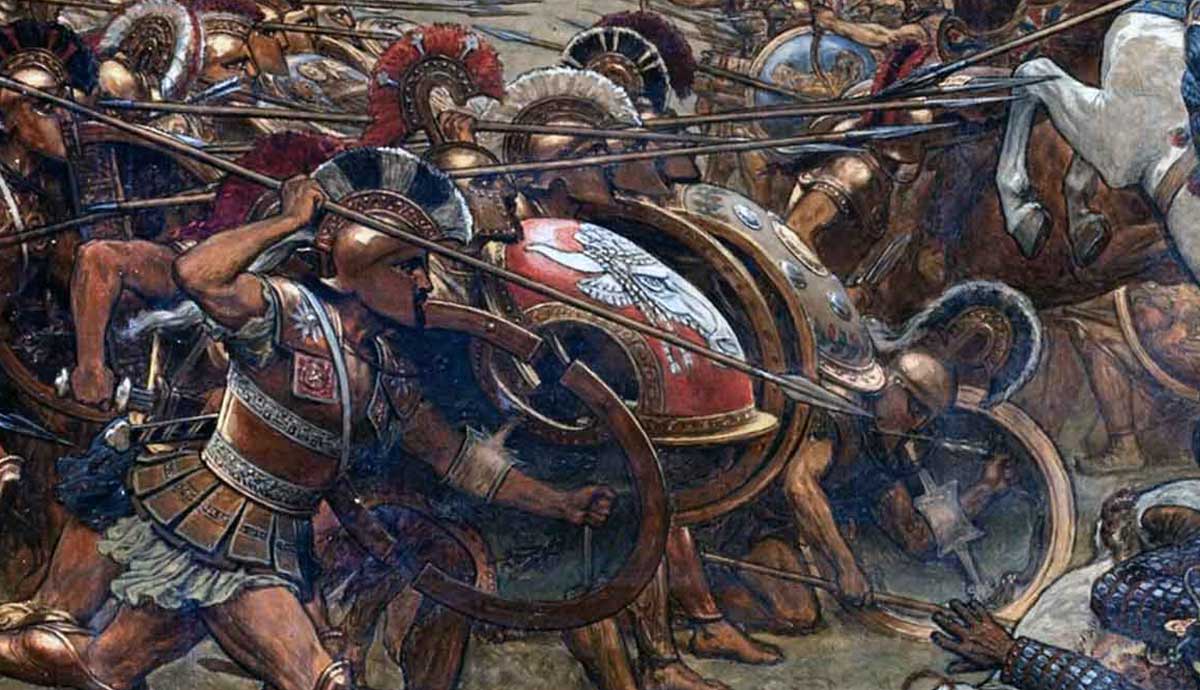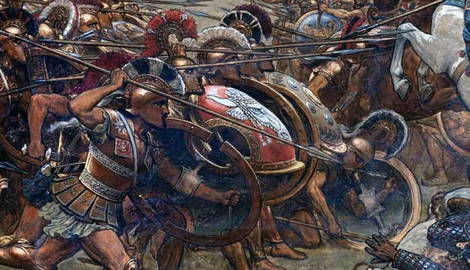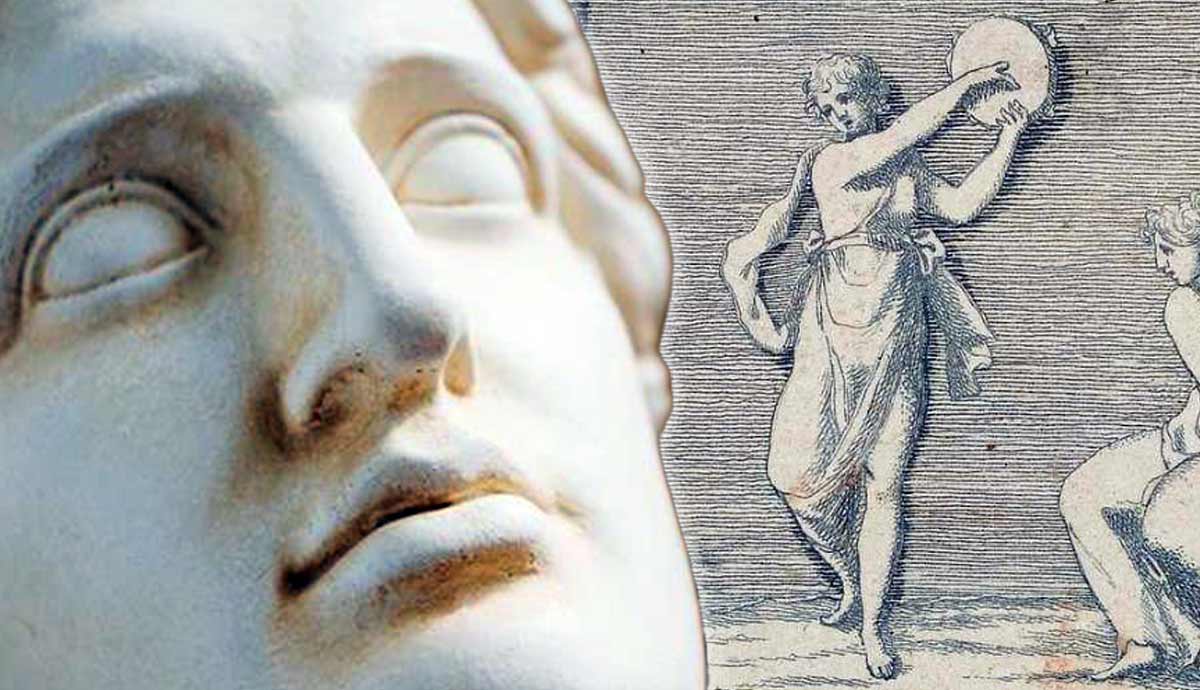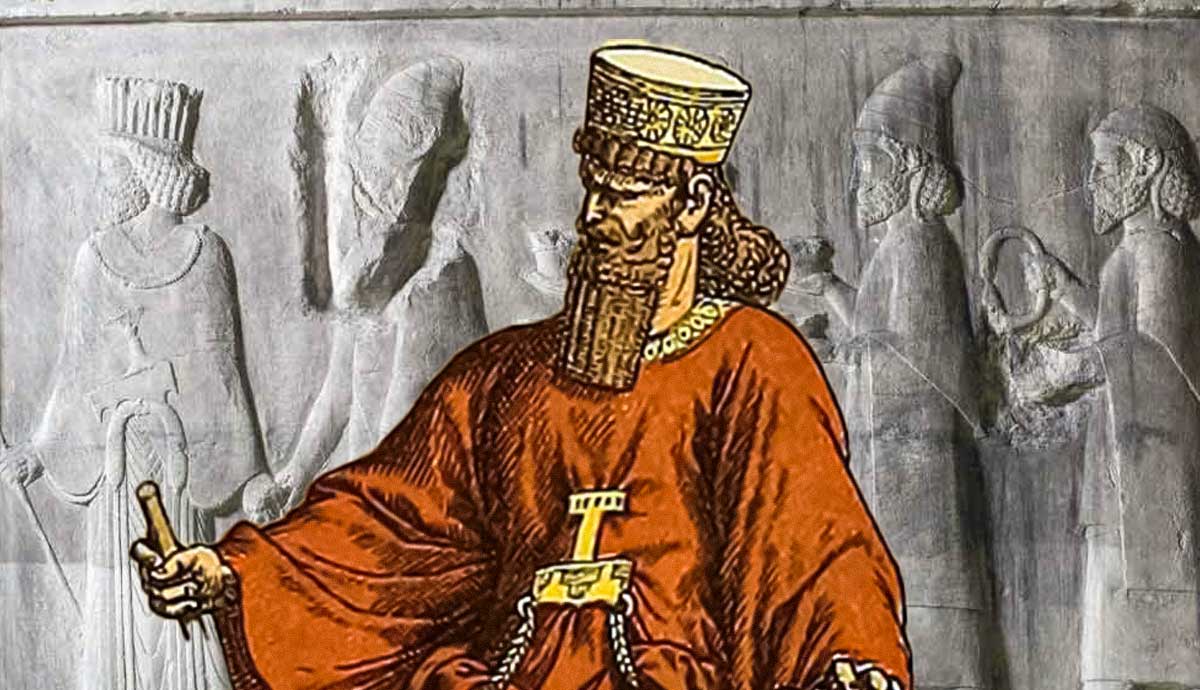
Active in the 4th century BCE, the Sacred Band was an elite military unit composed of 150 pairs of male lovers. The central idea was that by placing each soldier alongside his beloved, they would fight more fiercely, to both protect one another and to avoid dishonoring themselves in their partner’s eyes. Through their valiant efforts, they helped bring an end to Spartan hegemony and established Thebes as a dominant military power in ancient Greece. This article will discuss the Band’s formation, major victories, and eventual defeat at the hands of Alexander the Great.
Founding and Philosophy of the Sacred Band

The year is 382 BCE, the Spartans have just seized the Cadmea of Thebes (the city’s ancient citadel), and installed a pro-Spartan oligarchy which will dominate the city for the next three years. However, in 379 BCE, a group of Thebans who had been exiled by the new Spartan regime led a daring coup to overthrow this oligarchy, expel the Spartan garrison, and reestablish Theban democratic leadership.
While the date of the formation of the Sacred Band is disputed, it is generally agreed to have taken place around 378-375 BCE, shortly after Thebes gained its independence. Formed at a crucial moment, the Band’s purpose was to protect and further Theban interests, defend against Sparta, and help Thebes in asserting its military and political independence.
The formation of the band is often attributed to the Theban commander Gorgidas. Plutarch writes that he handpicked 300 men for their exceptional personal abilities, regardless of social class, and trained them as an elite force. The 150 pairs were made up of one older lover and a younger partner, and Plutarch claims that the reason the group was called the “Sacred Band” was because the pairs would exchange vows at the shrine of Iolaus (the nephew and rumored lover of Heracles), as a model for their love.

The Greeks appear to have placed unique importance upon the number 300, viewing it as providing special cohesion for a fighting force. In 550 BCE, during a war between Sparta and Argos, both sides chose a group of 300 soldiers to represent them in battle. Famously, in 480 BCE, the Spartan king Leonidas led 300 of his men against a much larger force at the pass of Thermopylae.
Whatever the reason behind this tradition, Thebes’s own tightly knit group would prove to be a formidable force, winning victory after victory and temporarily establishing Thebes as the dominant military power in Greece.
Greek Eros

Same sex relationships amongst men were a common practice in ancient Greece, but there was a range of attitudes and beliefs surrounding the appropriateness of these relationships and their place and function in society.
In much of Greece, erotic love or “eros” between men was socially structured and age-differentiated. Typically, an older man, known as the erastes (the lover), would pursue a younger and often adolescent man, known as the eromenos (the beloved). It was believed that the older man would provide valuable mentorship for his younger lover, and that this was a healthy form of erotic attachment before he eventually grew up and found his own wife.
Thebes and the Unique Celebration of Eros

Thebes, however, appeared to hold these relationships in even higher esteem than many other Greek states, breaking the social norms and celebrating them beyond the pederastic tradition. Plato, in his Symposium, through one of his speakers, Pausanias, discusses the uniqueness of the Theban attitudes towards male eros. He claims that while in Athens and Sparta male eros may be “complicated,” in Thebes it was embraced, with men able to make vows to one another and even live together as if they were wed.
This unique attitude to male eros helps explain both the existence and success of the Sacred Band. By placing high value on these relationships, beyond traditional social structures, Thebes was able to harness romantic bonds as a powerful tool for military strategy.

In his Symposium, Plato ruminated on the potential value of creating an elite corps of lovers. Using the character of Phaedrus as his mouthpiece, he wrote:
“And if there were only some way of contriving that a state or an army should be made up of lovers and their loves, they would be the very best governors of their own city, abstaining from all dishonour, and emulating one another in honour; and when fighting at each other’s side, although a mere handful, they would overcome the world. For what lover would not choose rather to be seen by all mankind than by his beloved, either when abandoning his post or throwing away his arms? He would be ready to die a thousand deaths rather than endure this. Or who would desert his beloved or fail him in the hour of danger?”
While there is no definitive date for when the Symposium was written, it is generally placed around 380 BCE, roughly the same period when the Sacred Band is thought to have been formed. While we cannot say for sure whether Plato knew of the Sacred Band at this time, it is clear that he already understood just how powerful the utilization of such romantic bonds could be.
The Rise of Thebes: A New Power in Greece

In the early 4th century BCE, Thebes was still seen as something of a backwater compared to the more powerful city-states of Athens and Sparta. During the 5th century, while Athens and Sparta fought each other for dominance, Thebes largely remained on the sidelines and was not viewed as a serious contender for hegemony over Greece.
There was also lasting resentment toward Thebes for siding with the Persians during their 480 BCE invasion—the only major Greek city to do so. Beyond its political choices, Thebans were often stereotyped as slow-witted and rustic, with Boeotia, its neighboring region, frequently mocked in Athenian comedy as a land of “swine” and “clog-wearing farmers,” lacking the sophistication of their neighbors.
After defeating Athens in the Peloponnesian War in 404 BCE, Sparta had emerged as the dominant power in ancient Greece. Feared for their ruthless tactics and hardened, disciplined way of life, they built a reputation as nearly unbeatable on the battlefield. After their victory, they increased their dominion by installing pro-Spartan oligarchies in defeated city-states, but their harsh form of rule quickly led to widespread discontent across Greece, especially in their subject peoples.

The contention for leadership within Greece caused continual unrest. The 4th century BCE was marked by shifting alliances, political instability, and the breakdown of established power structures. Persian wealth and influence flowed into Greece, further destabilizing relations as Persian rulers manipulated Greek factions to serve their own interests. This fractured political landscape ultimately left Greece vulnerable to the rise of Macedon under Philip II and, later, his son Alexander the Great, who reshaped the region entirely.
It was during this turbulent century that Thebes rose to real prominence. With the emergence of noble and canny leaders such as Epaminondas and Pelopidas, and the success of the fighting strength of the Sacred Band, Thebes established itself as a major power, breaking Spartan dominance and briefly becoming the leading city-state in Greece.
First Victories: The Battle of Tegyra

In 375 BCE, the command of the Band was passed from Gorgidas over to Pelopidas, one of the Theban exiles who had liberated the Cadmea from its Spartan occupiers. Pelopidas was a statesman and general known for being charismatic, noble, and deeply patriotic. He was devoted to the Theban cause and determined to best their Spartan adversaries. With Pelopidas at its helm, the Sacred Band’s work began in earnest, and they were soon to have their first major victory.
Early on in his leadership, Pelopidas decided to target the city of Orchomenus, a major Spartan outpost in Boeotia. It was one of the few such cities that Sparta could supply easily by ship, and its strategic position made it a particularly valuable asset. Pelopidas hoped that, with the strength of his Sacred Band, he might be able to take this asset for Thebes and reassert their power in Boeotia.
The Theban intelligence network had caught wind that the Spartan garrison stationed in the city was departing on a raiding mission, and Pelopidas hoped his forces would be able to occupy Orchomenus before they returned. However, news soon arrived that after the last garrison departed, a new one had arrived by ship to replace it, and with the town too heavily defended, the Sacred Band were forced to turn back.

On their return, they passed by the shrine of Apollo at Tegyra. A nearby river had overflowed and was constricting the army’s track, hemming them in between the marshlands and the hills. Here, unexpectedly, they encountered the Spartan raiding party that had left Orchomenus, standing directly ahead of them with a force up to four times as large.
Pelopidas responded quickly, packing the Sacred Band together in close ranks with the Spartans assuming their traditional phalanx formation. The Band, with Pelopidas at its helm, charged forward at the two Spartan polemarchs (war leaders) on the right wing and, according to Plutarch, swiftly dispatched them.
Unable to rely on their numbers in the narrow pass, the Spartans could not outflank the Theban force, and they were eventually forced to retreat. The battle itself likely only lasted an hour or two, but the impact was significant. Not only had the Sacred Band dealt a blow to the Spartan forces, but perhaps more importantly, they had begun to chip away at the near invincible Spartan reputation. No land army had been able to stand up to the Spartan host in this way in many years, especially not one so outnumbered and taken by surprise.
The ancient Greek historian Diodorus Siculus writes of this encounter and claims that, from this victory, the Thebans “were filled with high spirit, and their courage was more widely proclaimed, and they clearly positioned themselves to compete for the headship of Greece.” The fame of the Sacred Band had begun to spread.
The Battle of Leuctra: Breaking Spartan Power

While Pelopidas was in control of the Sacred Band, his contemporary, friend, and rival Epaminondas often oversaw the larger strategic movements of the Theban army. In the years that followed the Battle of Tegyra, Pelopidas and Epaminondas rose to become some of the most impressive military leaders of their time and made substantial progress in furthering Theban interests.
For years, Thebes had been pushing to reestablish their Boeotian League—a federation of cities with themselves at the helm, that would allow the Thebans to further their influence and control of the region. Unsurprisingly, this was strongly opposed by the Spartans, who continued to seek hegemony over the Greek states.
In 371 BCE, Sparta held a peace congress to try and resolve some of these ongoing conflicts, but Thebes refused to sign the treaty unless it was allowed to do so on behalf of all of Boeotia, tacitly confirming their leadership of the entire area. The two Spartan Kings, Agesilaus II and Cleombrotus I, refused these conditions, and in response, King Cleombrotus was sent into Boeotia with a large Spartan army to force Thebes into submission.
The two forces encountered each other in the vicinity of Leuctra, a small village in Boeotia, situated on one of the hills on the edge of the Theban plain. Once again, the Thebans were heavily outnumbered, with estimates suggesting that the Spartan force was close to double that of the Thebans.
A New Strategy

Traditionally, in pitched warfare, both sides would place their strongest units on the right wing and the weaker ones on the left. If both right wings were victorious, they would then move toward the center to engage in battle with each other.
Epaminondas decided to go a different route. He placed the Sacred Band—their strongest fighting force—on the left wing, thus leaving their right wing weak and exposed. Epaminondas knew that the troops on this right wing were not the Spartans themselves, but rather their allies, many of whom had reasons to resent their Spartan commanders. Epaminondas thus instructed the right wing to hold back or even withdraw their forces if their enemies advanced, hoping to avoid unnecessary contact.
In this unconventional positioning, the Theban left, led by Pelopidas and the Sacred Band, rushed forward. The Spartan King Cleombrotus was wounded and fell back, soon succumbing to his injuries, and shocked by the speed and violence of their attack, the Spartan allies fled from the field. Without the support of their allies or the leadership of their King, the Spartan line began to collapse. Until now, the Spartans had not been turned in the open field in the past three centuries, but without their leader and after having sustained heavy losses, they ran for high ground.

The remaining Spartan polemarchs sent to Thebes for a truce to recover their dead, a formal admission of defeat. Epaminondas granted this truce on the condition that the Spartans first sent out their allies, city by city, to collect the dead of their own countrymen. He knew that in the past Sparta had concealed the scale of their losses by mingling their dead with those of their allies, and he wanted to expose the true extent of their defeat. The Spartans had never suffered such a resounding open-field loss, and their all-important claims of invincibility were beginning to crumble.
This loss, engineered primarily by the strength of the Sacred Band, was the beginning of the dismantling of Sparta’s power in Greece. Following their victory, Thebes went on to liberate Messenia from Spartan overlordship and provide support for several anti-Spartan states such as Arcadia and Tegea. Sparta, famously an oligarchic power, was countered by Epaminondas’s democratic regimes, allowing autonomy for smaller Greek states and turning the tide in favor of Thebes. Sparta never fully recovered, and never again reached the heights it had during the 4th century BCE—instead, Thebes had begun to assert itself as the preeminent force in all of Greece.
The Fall of the Sacred Band: The Battle of Chaeronea

After their groundbreaking success at Leuctra, the power and influence of Thebes continued to grow under Pelopidas and Epaminondas, with the Sacred Band as their enforcing arm. However, in 364 and 362 BC respectively, both of these talented commanders were killed in conflict, and without them Theban leadership faltered.
During this time, Philip II of Macedon, the father of Alexander the Great, was reforming the Macedonian army and gaining power in the North. Alarmed by Philip’s quick success and the effectiveness of his military reforms, Athens and Thebes, despite a tempestuous relationship and ever-shifting alliances, formed a new alliance to counter Philip and defend Greek autonomy. Both sides eventually met near Chaeronea, in Boeotian territory, for a battle that would permanently alter the fate of Greece.
It is said that over 35,000 took to the field against Philip, making it one of the largest united forces that Greece had ever managed to assemble. In this battle, the Sacred Band comprised a small portion of the overall soldiers, but its impact far outweighed its size.

Although Epaminondas and Pelopidas had much success in placing their strongest forces on the left wing, the new commanders chose to abandon this tactic, instead placing themselves and the Band on the right side, returning to the traditional formation. In doing so, they left the less experienced and less militarily confident Athenians to face Philip.
It seems likely that the Theban commanders intended to win their victory on the right with enough time to come to the aid of the Athenians. To do so, they would have to encounter and defeat Philip’s 18-year-old son, Alexander, in his first open field battle.
In the past, the Band had been the ones to charge on the run, smashing straight into the enemy line. This time, however, Alexander beat them to it. Spying a gap that had opened between their Thebans and their allies, he charged forward. Cut off from their neighbors and unable to protect their left flank, Alexander peeled off line after line of the Band, with the relentless pressure of Macedonian spears. In the meantime, Philip had had similar success with the Athenians, with a thousand killed by the end of the morning and many more captured and taken prisoner.
The Rise of Macedon

After his rousing success, Philip made his way over to where Alexander stood and found that his swift action had allowed him to succeed in killing every single member of the famous Sacred Band.
Plutarch describes in detail the moment in which Philip saw the destruction. Claiming that when he saw them “mingled together”—a word that in Greek has erotic overtones, he was moved to tears, saying “perish all those who suggest that these men did or endured anything shameful.”
Philip was, in fact rumored to be the eromenos of Pammenes, who according to some sources was the Theban general who first decided that the lovers should be stationed immediately beside each other; Plutarch describes Philip as being clearly moved by the site of the intermingled corpses, perhaps thinking of his own lover.
In the aftermath of Chaeronea, Philip continued his dominance and eventually handed over the reins to his young son Alexander, who went on to launch his famous and incredibly successful Persian expedition, and in 335 BCE, Alexander brutally razed the entire city of Thebes to the ground for revolting against his rule.
The Sacred Band died valiantly, but their efforts ultimately were in vain, with the hegemony of Greece passing into the hands of Macedonian monarchs. Though there were varying degrees of local forms of governance, from this point on, foreign policy was largely controlled by Macedon. This marked the transition from the Classical to the Hellenistic era, and in many ways was the end of Greek autonomy.
Legacy of the Sacred Band

The tumulus of the Sacred band was uncovered by archaeologists in the late 19th century. Several of the skeletons were found with their arms still linked, bearing the wounds of their final battle. Near the site, they found pieces of a large stone lion that were later reassembled and restored to their original position, making it one of the oldest standing war memorials in Greece. The lion bears no inscription, and ancient Greek author Pausanias wrote, “It seems to me the inscription is lacking because their fortunes were not equal to their courage.” Thus, no loss is admitted at this site, but it stands rather as a record of their bravery and evidence of their love.
The story of the Sacred Band clearly had a lasting impact on the cultural imagination, and the unearthing of their skeletons inspired a new wave of interest. They are said to be the inspiration behind Walt Whitman’s poem The Centenarian’s Story, and George Cecil Ives, a 20th century writer and poet, even went on to found what he called the Order of Chaeronea—a somewhat mystic group that promoted fraternity and camaraderie among gay men in a society that dismissed and demonized them.
This group secretly financed the restoration of the Lion at its original site, and it still stands today as a symbol of loyalty, honor, and valor in the face of seemingly unbeatable odds, as well as the profound strength of human bonds.









